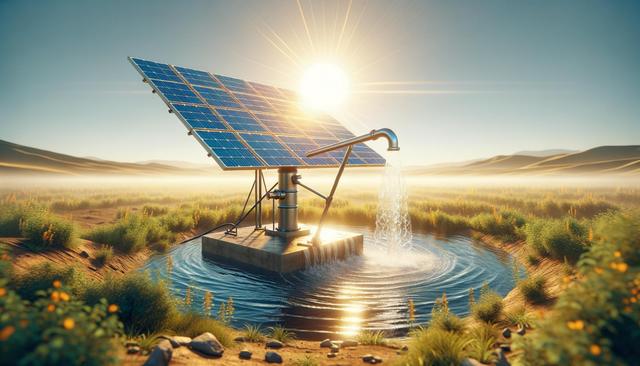Understanding Solar Water Pumps
Solar water pumps are innovative systems that utilize solar energy to pump water from wells, rivers, or reservoirs. These systems are particularly useful in off-grid or remote areas where access to electricity is limited or unreliable. The main components typically include solar panels, a controller, an electric pump, and in some cases, batteries for energy storage. The solar panels convert sunlight into electricity, which powers the pump to move water.
There are two main types of solar water pumps: surface pumps and submersible pumps. Surface pumps are ideal for shallow water sources, while submersible pumps are designed for deep wells. The choice depends on the depth of the water source and the amount of water needed.
Key benefits of solar water pumps include:
- Reduced dependence on fossil fuels
- Lower operating and maintenance costs
- Minimal environmental impact
- Improved accessibility to water in rural areas
Understanding how these systems work is essential before investing in one, as it helps in selecting the most suitable model for your specific application.
Applications in Agriculture and Beyond
One of the primary uses of solar water pumps is in agriculture. Farmers rely on them to irrigate crops, water livestock, and maintain soil moisture levels. In regions with ample sunlight, solar pumps provide a reliable alternative to diesel-powered or grid-tied pumps, significantly cutting down on fuel and electricity expenses.
Aside from agriculture, solar water pumps are also used for:
- Supplying drinking water in remote villages
- Fish farming and aquaculture
- Garden and landscape irrigation
- Water circulation in ponds and water features
In humanitarian contexts, solar water pumps have been instrumental in improving access to clean water in disaster-stricken or impoverished areas. Their ability to function independently of traditional power sources makes them invaluable in emergency responses and long-term development projects.
The versatility of these systems makes them a practical choice for a wide range of users, from small-scale farmers to large commercial operations.
Installation and Maintenance Considerations
Proper installation is critical to the performance and longevity of a solar water pump system. Factors to consider include site selection, solar panel orientation, and pump sizing. A well-sited system maximizes sun exposure and ensures efficient water delivery. Installers should also evaluate the water source’s depth and quality to choose compatible pump components.
Routine maintenance helps extend the lifespan of the equipment. Basic maintenance tasks include:
- Cleaning solar panels to remove dust and debris
- Inspecting electrical connections and wiring
- Checking for pump wear and tear
- Ensuring filters and valves are not clogged
While solar water pumps are generally low-maintenance, occasional servicing by a professional is recommended to address any technical issues and optimize performance. Some systems come with remote monitoring features, allowing users to track energy production and water output in real-time.
By planning for regular upkeep, users can ensure consistent operation and avoid unexpected downtime.
Cost and Financial Incentives
The initial cost of a solar water pump system can be a concern for some users. However, it’s important to consider the long-term savings and potential financial incentives available. The upfront investment typically includes the cost of solar panels, the pump, installation, and optional battery storage. Over time, the savings on energy or fuel costs can offset this initial expenditure.
In many countries, government subsidies, grants, or tax incentives are available to encourage the adoption of renewable energy technologies. These programs can significantly reduce the financial burden for individuals or organizations investing in solar water pumping systems.
Factors influencing the total cost include:
- System size and pump capacity
- Quality of components
- Installation complexity
- Optional features like remote monitoring or battery backup
When evaluating costs, it’s also useful to compare the lifetime costs of solar pumping systems with conventional alternatives. The absence of ongoing fuel expenses and lower maintenance needs often result in a favorable return on investment over time.
Choosing the Right Solar Water Pump
Selecting the most appropriate solar water pump depends on several variables, such as water requirements, site conditions, and budget. Before purchasing, it’s essential to assess daily water needs, whether for irrigation, livestock, or household use. This information helps determine the necessary flow rate and system capacity.
Other important considerations include:
- Depth and type of water source
- Solar availability in the region
- Desired hours of operation
- System durability and warranty coverage
Consulting with a solar energy expert or installer can help match your needs to available products and configurations. Many reputable manufacturers offer modular systems that can be scaled up or down based on demand. For those with fluctuating water needs, hybrid systems that combine solar with another power source may offer added flexibility.
Taking the time to evaluate all relevant factors ensures that the selected system meets both short-term needs and long-term sustainability goals.
Conclusion: Embracing Solar for Sustainable Water Solutions
Solar water pumps offer a practical and eco-friendly solution for individuals and communities seeking to improve water access without relying on fossil fuels. From agricultural irrigation to domestic supply, their versatility and low operating costs make them an increasingly popular choice for sustainable living. By understanding how these systems work, evaluating installation needs, and considering financial incentives, users can make informed decisions that support both their immediate water needs and long-term environmental goals.







